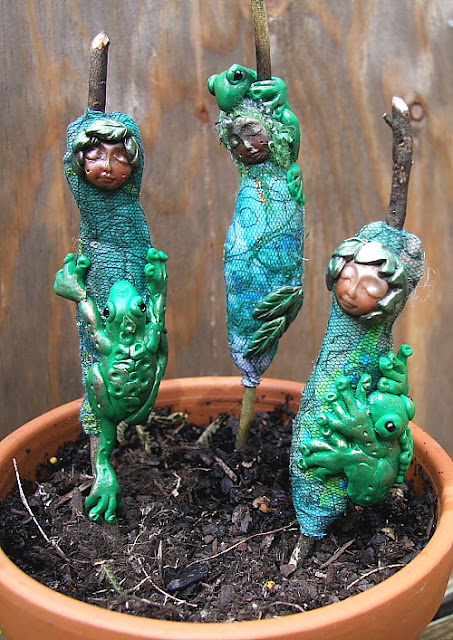This week, when I was trying to think of what to create for this month’s Art Dolls Only Challenge – Animal Totems. I first thought of my owl woman doll, who now lives with my sister in her owl collection.
Further research found these little snippets of information:
In China the Frog is an emblem of Yin energy and thought of as good luck. Feng Shui practices recommend putting an image of a Frog in the east window of your home to encourage child birth and/or happy family life. Frogs are also good luck symbols in Japan - especially for travellers. Images or charms were worn during long voyages to assure safety (particularly across water). As a Celtic symbol, the Frog was deemed lord over all the earth, and the Celts believed it represented curative or healing powers because of its connection with water and cleansing rains
One animal symbolism source says "Call upon the energy of the frog when you need to easily swim through some tough life-transitions"... To all those affected in floods not only here in Australia but also in other countries, may the transition from disaster to happier times be easier than ever imaginable and anticipated.
However, with the news of the devastating floods in Queensland, and now in Victoria and NSW in my thoughts, I couldn’t get the image of green frogs and the Aboriginal story of Tiddalik out of my mind. The tale of "Tiddalik the Frog" is a legend from the Dreamtime mythology of the Indigenous Australians. In the legend, Tiddalik awoke one morning with an unquenchable thirst, and began to drink until all the fresh water was greedily consumed. Creatures and plant life everywhere began to die due to lack of moisture. Other animals conspired against Tiddalik, and devised a plan for him to release all of the water he had consumed. This was successfully coordinated by a wise old Wombat, when Nabunum the eel made Tiddalik laugh when he tied himself in comical shapes. As Tiddalik laughed, the water rushed out of him to replenish the lakes, swamps and rivers. (from Wikipedia)
It all came together quickly – some green layered “pizza” fabric I made last week and a few drawings later these three little dolls came to life.
These little dolls were inspired by this North Western story … Yet another Frog legend says a village was starving because no one could catch any fish or game, so a warrior went out to try to find some food. No one had been successful for a long time. The warrior met a bird that instructed him to follow, so he could help him. The bird brought him to a Frog, who let the warrior wear his skin. With the Frog skin, the warrior was able to get enough food for the whole village but, as time passed, the warrior was fully transformed into a Frog, and he went to sea. There he could live and catch fish and other seafood. Until his days were no longer he provided these foods to his village. My frog totem art dolls have not yet fully transformed into frogs…Further research found these little snippets of information:
In China the Frog is an emblem of Yin energy and thought of as good luck. Feng Shui practices recommend putting an image of a Frog in the east window of your home to encourage child birth and/or happy family life. Frogs are also good luck symbols in Japan - especially for travellers. Images or charms were worn during long voyages to assure safety (particularly across water). As a Celtic symbol, the Frog was deemed lord over all the earth, and the Celts believed it represented curative or healing powers because of its connection with water and cleansing rains








I like your frog totoms. Very cool. and the animated little frog is cool too! My blog needs a facelift want to help!!
ReplyDeleteLove these!!! I love frogs! Your dolls are really great!!Good work!!Looks like you had fun too.
ReplyDelete